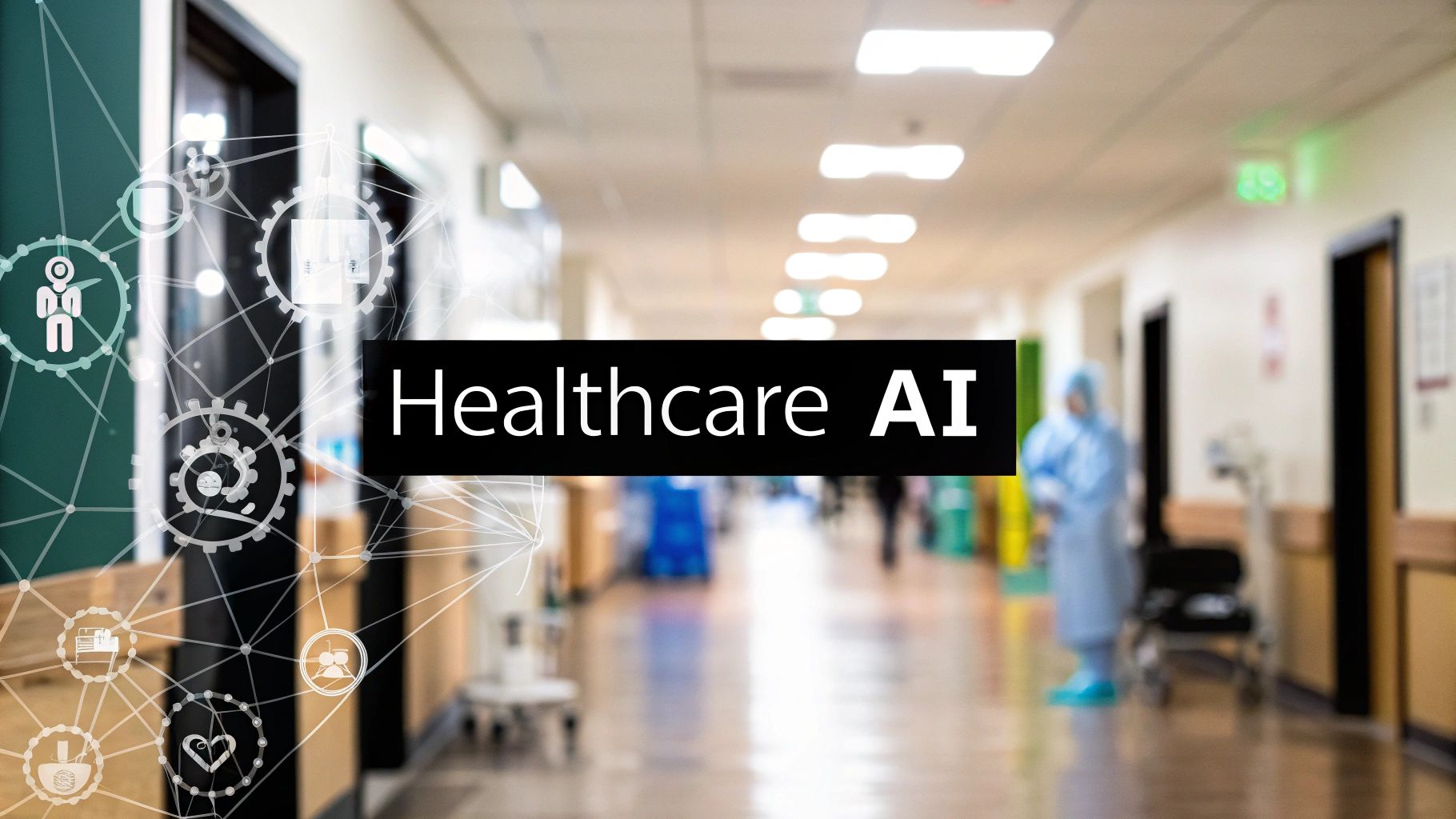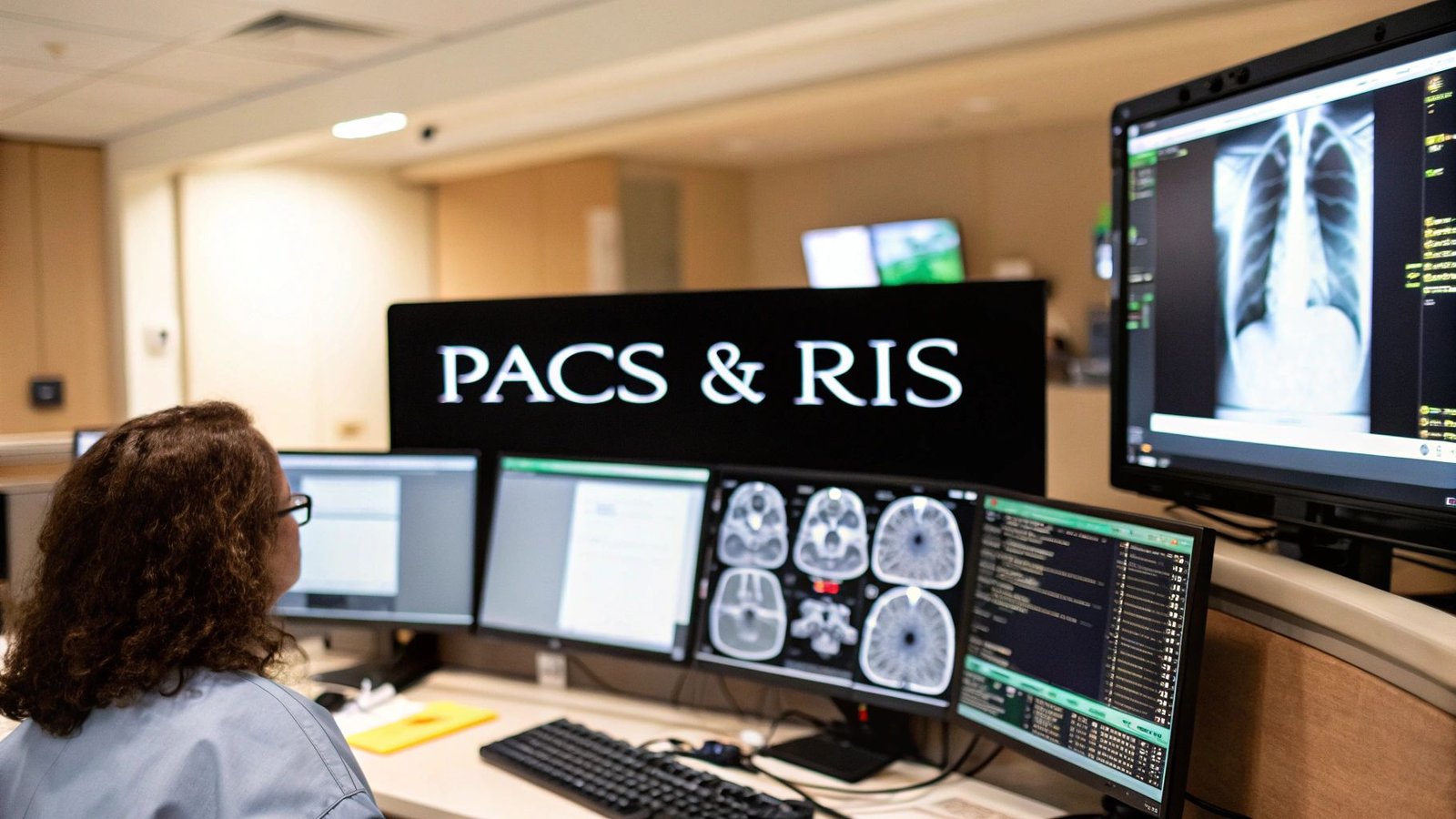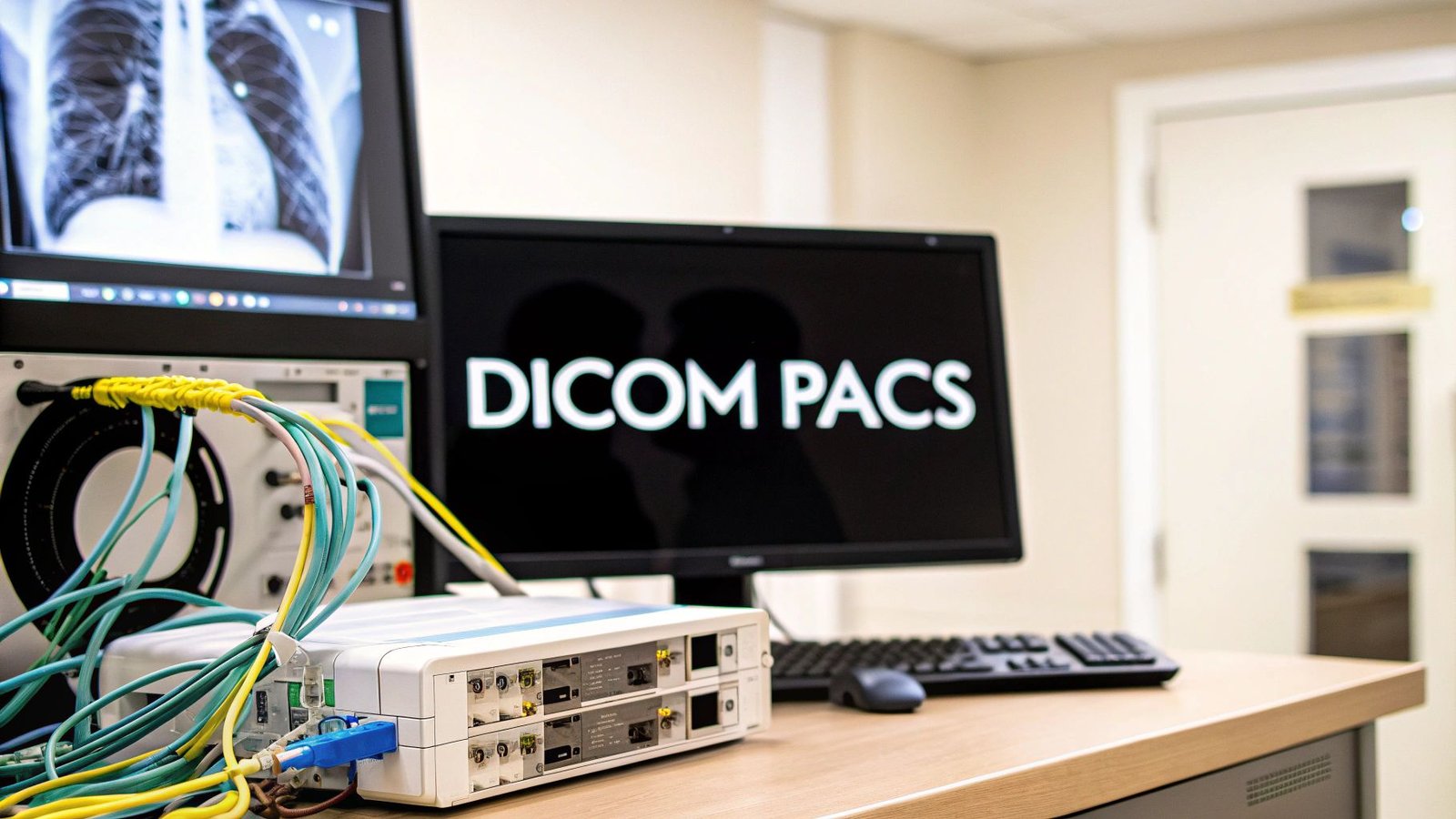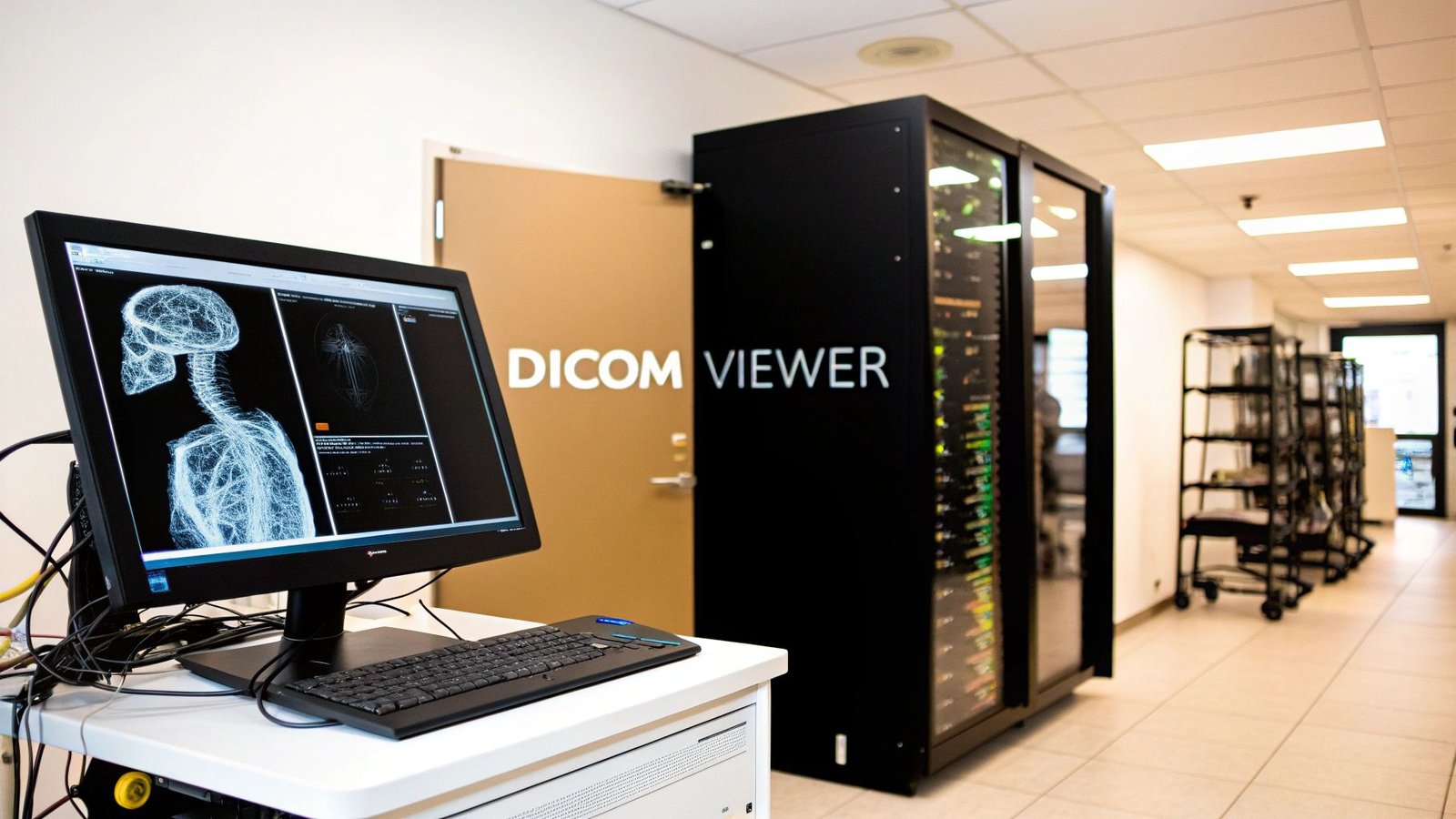Think of healthcare AI less as a single technology and more as a team of specialized digital assistants, each designed to support medical professionals in a specific way. These aren't far-off futuristic concepts; they are practical tools being used right now to help clinicians sift through complex data, automate tedious tasks, and ultimately, improve the quality of patient care.
The New Reality of AI in Modern Medicine
Artificial intelligence is making its mark on medicine in a way that’s reminiscent of game-changing inventions like the X-ray. Just as radiography gave us the ability to see inside the human body for the first time, AI gives us the power to see patterns in vast datasets that are invisible to the naked eye. This opens up entirely new avenues for understanding and treating disease.
Today's healthcare systems are grappling with some monumental challenges—from the overwhelming burden of administrative work to the diagnostic riddles posed by rare conditions. AI steps in to provide much-needed relief. It can analyze millions of clinical notes, lab results, and medical images with incredible speed, pulling out critical insights that help care teams make faster, more informed decisions.
Defining Core AI Categories
Healthcare AI isn't a one-size-fits-all solution. It's a collection of specialized tools, and knowing the main categories helps clarify how and where they create value in a clinical or hospital setting.
To make this clearer, let's break down the main types of AI solutions you'll find in healthcare today.
Key Categories of Healthcare AI Solutions at a Glance
This table gives a quick overview of the primary AI categories, what they do, and the core benefits they bring to the table for both patients and providers.
| AI Solution Category | Core Function | Key Benefit |
|---|---|---|
| Diagnostic & Imaging AI | Analyzes medical images (X-rays, CTs, MRIs) and pathology slides to spot anomalies. | Increases diagnostic accuracy and speed, helping clinicians detect diseases earlier. |
| Operational & Administrative AI | Automates workflows like scheduling, billing, and patient record management. | Reduces administrative costs, minimizes staff burnout, and improves hospital efficiency. |
| Personalized Medicine & Treatment AI | Analyzes patient-specific data (genetics, lifestyle) to predict treatment outcomes. | Enables customized, more effective treatment plans with fewer adverse side effects. |
| Patient Engagement & Monitoring AI | Powers chatbots, virtual health assistants, and remote monitoring devices. | Provides patients with 24/7 support, improves chronic disease management, and reduces hospital readmissions. |
Each of these categories addresses a different piece of the healthcare puzzle, working together to create a more efficient and effective system.
"The true purpose of healthcare AI is not to replace the skilled professional but to augment their abilities. It acts as a powerful collaborator, handling the data-heavy lifting so clinicians can focus on what they do best: providing compassionate, expert care to patients."
The move toward these technologies is happening fast. A recent survey found that a staggering 86% of healthcare organizations are now extensively using AI in some form. This isn't just a trend; it's a fundamental shift, with the global market for these tools expected to shoot past $120 billion by 2028.
This rapid adoption is a direct answer to real-world pressures like growing patient numbers, long wait times, and a tired workforce. By tackling these issues head-on, healthcare AI solutions are quickly becoming essential for any modern medical practice. For a deeper look at this growth, you can find more insights about AI's expansion in healthcare.
How Core AI Technologies Work in Healthcare
To really get a handle on healthcare AI solutions, we have to pop the hood and see what makes them run. It's best not to think of AI as some single, magical thing. Instead, picture it as a specialized toolkit where each tool has a very specific and powerful job. Once you understand the individual tools, it's much easier to see how they all work together to help clinicians and improve how we care for patients.
Machine Learning: The Pattern-Finding Powerhouse
At the core of most AI systems, you'll find Machine Learning (ML). Imagine a medical resident who could somehow study millions of patient charts, lab results, and treatment histories in a single afternoon. That's essentially what ML models do. They are "trained" on massive datasets to spot subtle patterns and connections that are simply impossible for the human brain to catch on its own.
For example, an ML algorithm can sift through thousands of patient records to flag individuals at the highest risk of developing sepsis. It learns the specific cocktail of vital signs, lab values, and demographic details that often signals a coming crisis. This gives clinical teams a crucial head start, letting them step in long before the patient's condition becomes critical.
This is where AI gets really practical, integrating directly into the patient's journey to support both the doctor and the person they're treating.
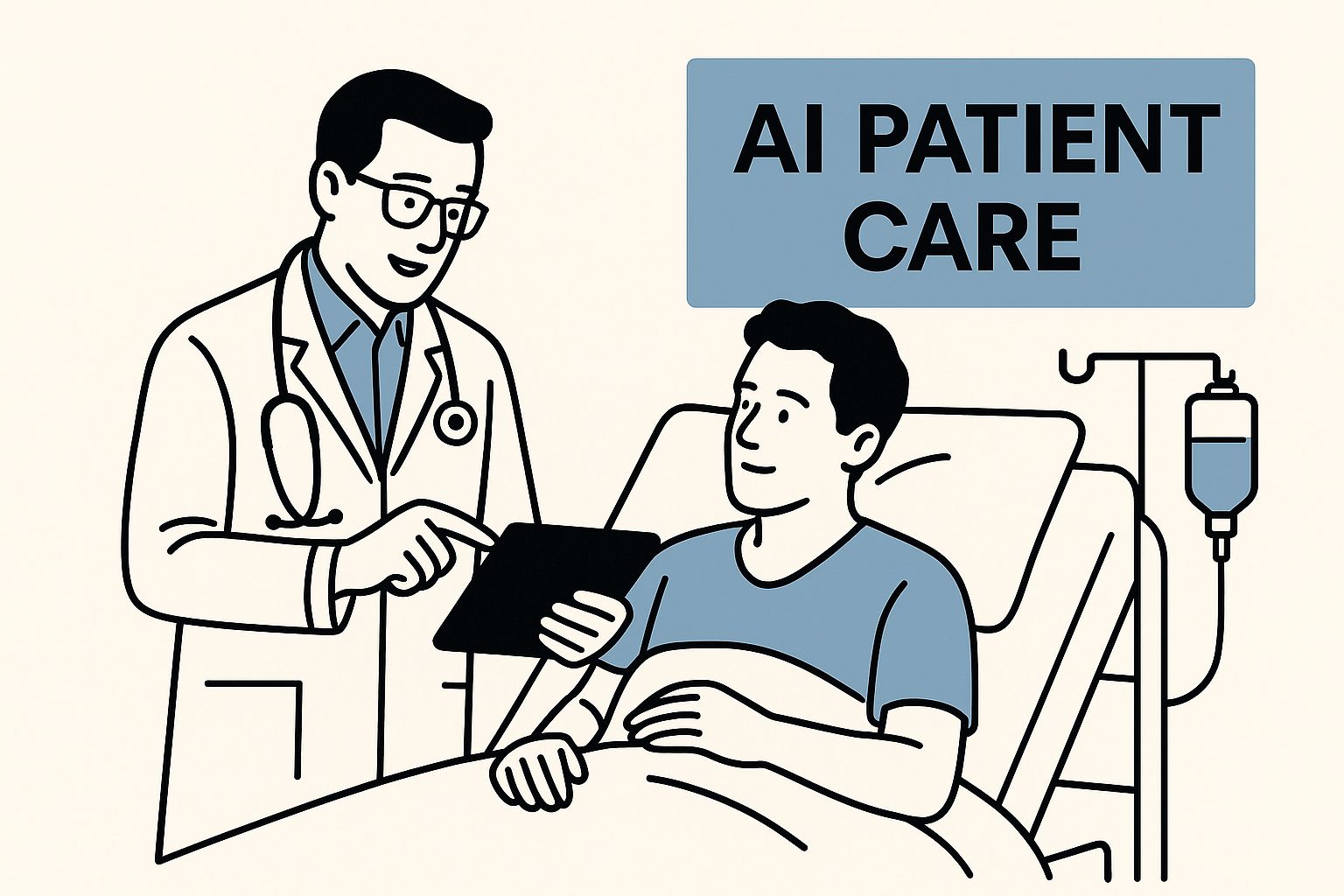
As you can see, the goal is to use AI right at the point of care, where it can synthesize information and help clinicians make better, faster decisions.
Making Sense of Medical Language
Another vital piece of the puzzle is Natural Language Processing (NLP). So much of healthcare is built on language—from doctors' scribbled notes and transcribed appointments to dense medical journals and patient emails. NLP acts as a super-smart translator and interpreter for all of this unstructured text.
Think of it as the ultimate assistant. It can read a messy, jargon-heavy clinical note and instantly pull out the key facts: diagnoses, medications, symptoms, and procedures. This ability is a game-changer for cutting down on administrative busywork.
By turning unstructured text into structured, usable data, NLP directly tackles physician burnout from manual charting. It lets technology handle the tedious clerical tasks, giving clinicians more time for what they do best: talking to and caring for patients.
This technology is already making a huge impact in several ways:
- Ambient Scribing: AI listens in on a doctor-patient conversation and automatically creates a structured clinical note, slashing documentation time.
- Intelligent Chatbots: NLP allows virtual assistants to understand what patients are asking, provide reliable health information, and guide them through the healthcare system.
- Research Analysis: Scientists can use NLP to scan millions of published studies in minutes, quickly spotting new trends or evidence for treatments.
The Power of Computer Vision
Finally, we have Computer Vision, which gives machines the ability to "see" and make sense of visual information. In healthcare, its most famous role is in medical imaging. An AI model trained with computer vision can analyze X-rays, CT scans, and MRIs with incredible accuracy.
Picture a radiologist who has looked at millions of scans and has developed an almost sixth sense for spotting the faintest signs of trouble. Computer vision models are trained to do exactly that, often picking up on tiny patterns that are too subtle for the human eye. It doesn't replace the radiologist; it serves as a tireless second set of eyes.
Here’s a simplified look at how it works:
- Training the AI: The model is shown thousands of labeled images (e.g., scans marked with "cancerous nodule" or "no nodule").
- Learning Patterns: Over time, it learns the specific pixels, textures, and shapes linked to different medical conditions.
- Analyzing New Scans: When given a new, unseen scan, it can highlight suspicious areas with a certain probability, flagging them for an expert to review.
These three technologies—Machine Learning, NLP, and Computer Vision—are the building blocks of modern healthcare AI solutions. By learning from data, understanding language, and interpreting images, they create a powerful support system that elevates clinical expertise and pushes for a higher standard of care. For medical device companies, integrating these AI capabilities with a partner like PYCAD can fast-track the creation of next-generation diagnostic tools.
The True Impact on Patients and Providers
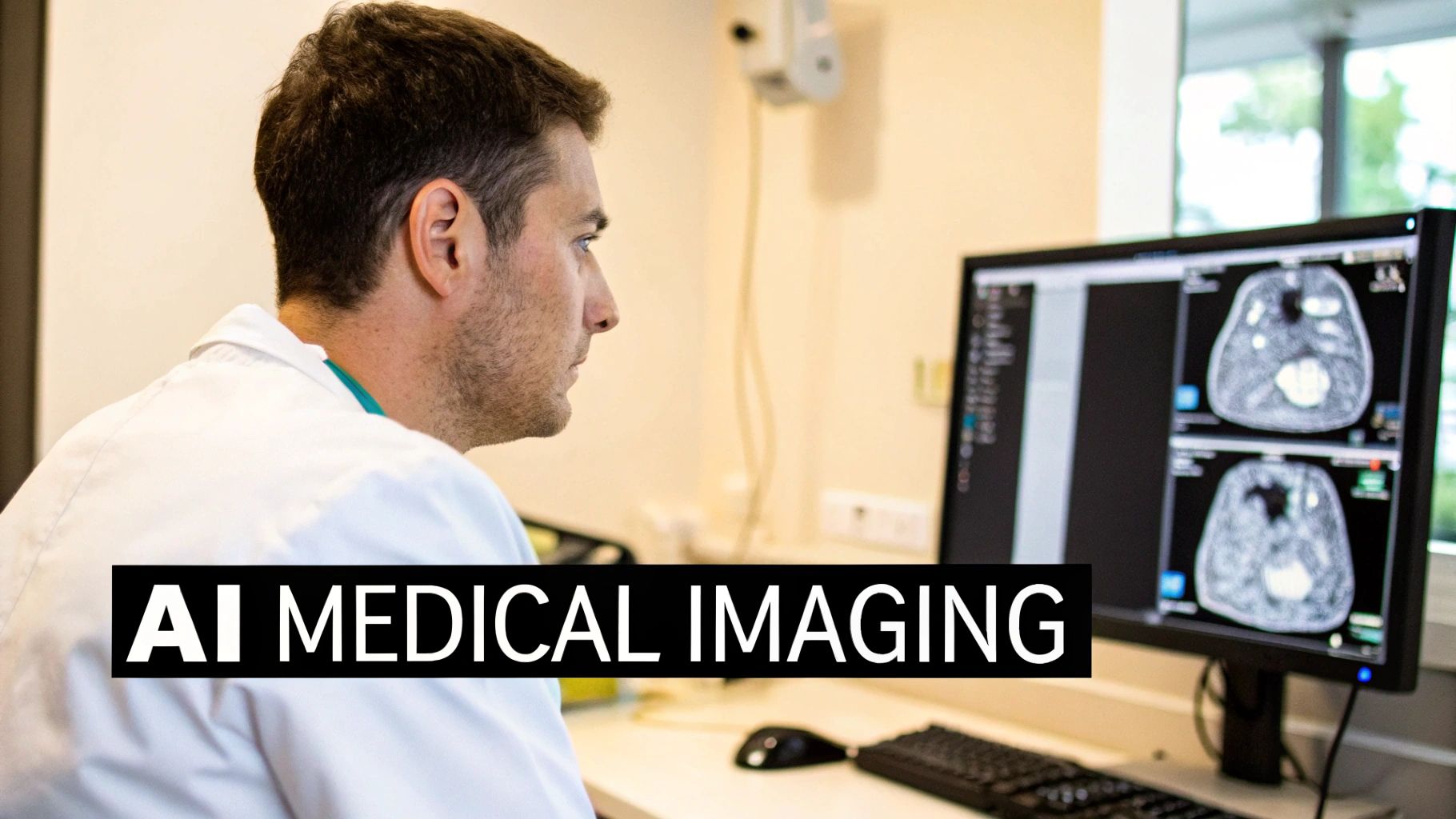
This is where the rubber meets the road—where all the talk about technology becomes a tangible reality for people. Beyond the algorithms and data crunching, healthcare AI solutions have a direct, profound effect on the lives of both patients and the clinicians caring for them. These benefits aren't just theoretical; they're practical, measurable, and deeply human.
We hear "better diagnostics" all the time, but what does that really look like? Imagine a radiologist staring at a lung scan, searching for the earliest signs of cancer. To the naked eye, a dangerous nodule might be almost invisible, lost in a sea of visual information. An AI tool, having been trained on millions of similar images, can flag these subtle anomalies with incredible accuracy, guiding the expert's focus to what matters.
This isn't about replacing the expert. It's about giving them a super-powered magnifying glass, helping them catch disease earlier when treatments are far more effective. It's a partnership that elevates the physician's skill, improves outcomes, and gives patients a much better shot at recovery.
Reclaiming Time for Patient-Centered Care
The impact goes well beyond diagnostics. Healthcare is drowning in administrative work, and it’s stealing precious time that clinicians would rather spend with their patients. This is where operational AI makes a huge difference.
Think about the relentless grind of scheduling appointments, managing patient records, and chasing down billing details. AI-powered systems can handle these repetitive jobs with stunning efficiency. An intelligent scheduler can untangle complex calendars in seconds, while an AI assistant can pull up a patient's complete history for a doctor to review in an instant.
The most significant contribution of operational AI is giving time back to healthcare professionals. By automating administrative overhead, it frees up nurses, doctors, and support staff to focus on what matters most: human connection, empathy, and direct patient care.
That recovered time translates directly into higher-quality interactions. Instead of rushing through appointments just to stay on schedule, providers can have more meaningful conversations, listen more closely to their patients' concerns, and build stronger, more trusting relationships.
The Dawn of Truly Personalized Medicine
Perhaps the most exciting frontier for healthcare AI solutions is the move toward truly personalized treatment plans. For decades, medicine has mostly been a "one-size-fits-most" game, with treatments based on what works for the average person. AI is completely flipping that script.
By analyzing a patient’s unique biological data, genetics, and lifestyle, AI can start to predict how they'll respond to different therapies. This includes:
- Genetic Analysis: AI can look at a person’s genetic markers to pinpoint which drugs will work best and which might cause nasty side effects.
- Lifestyle Factors: The system can factor in diet, exercise, and even environmental exposures to get a complete picture of a patient's health.
- Predictive Modeling: It pulls all this data together to forecast how a disease might progress and recommend a treatment strategy designed for that one individual.
This kind of personalization used to be science fiction. Today, it allows an oncologist to choose a chemo regimen based not just on the cancer type, but on the patient’s specific genetic code. The result is better treatment with fewer side effects, pushing medicine into a future where care is as unique as the person receiving it.
The growth here is staggering. The generative AI corner of healthcare alone is expected to hit $2.7 billion and is projected to explode to nearly $17 billion by 2034. But despite this incredible potential, healthcare is still behind other industries in AI adoption. This gap is a major roadblock to serving the 4.5 billion people worldwide who still lack access to basic health services. You can explore more on how AI is transforming global health. By finally closing this adoption gap, we can build a much more resilient and equitable healthcare system for everyone.
Healthcare AI Solutions in the Real World
It's one thing to talk about the theory behind AI, but the real magic happens when you see it at work in a hospital. Let's step away from the abstract concepts and into the clinic to look at some compelling stories of how healthcare AI solutions are already making a real difference. These aren't far-off possibilities; they are practical tools solving urgent, everyday problems right now.
Accelerating Cancer Diagnosis in Oncology
Imagine a busy oncology clinic. Day in and day out, pathologists are hunched over microscopes, examining an endless stream of pathology slides. Each one demands intense concentration to find the tell-tale signs of cancerous cells—a process that is both exhausting and incredibly high-stakes. The pressure is immense because for a patient waiting to start treatment, every single day counts.
This is where a specialized AI solution comes into play. The clinic brought in an AI system that was trained on hundreds of thousands of digital pathology images.
- The Problem: Pathologists were completely overloaded, leading to potential diagnostic delays and the risk of subtle human error when identifying cancerous tissue.
- The AI Solution: The system acts as a first pass, pre-analyzing every digital slide and automatically highlighting suspicious areas that look malignant. It essentially points a giant arrow at the most critical regions, directing the human expert's focus where it's needed most.
- The Measurable Result: With the AI's help, pathologists now review slides much faster, cutting their diagnostic turnaround time by over 30%. Even better, the AI acts as a vigilant second set of eyes, catching anomalies that might have been missed. This means doctors can confirm a diagnosis and start planning treatment sooner, giving patients clarity and hope when they need it most.
For these sophisticated tools to work, they need a solid foundation. You can learn more about this crucial backbone by exploring comprehensive Healthcare IT Services.
Predicting Cardiac Events Before They Happen
In a cardiology unit, the clinical team is always on high alert, watching patients at risk for sudden heart attacks. The real challenge is figuring out which patient is starting to decline before a full-blown crisis erupts. Standard procedure involves periodic checks of vital signs, but a patient’s condition can change in a heartbeat, literally.
To get ahead of this, a large hospital’s cardiology department rolled out a predictive AI model.
- The Problem: It’s impossible to watch every at-risk patient continuously, making it difficult to predict who is on the verge of a serious cardiac event.
- The AI Solution: The AI taps directly into the real-time data streaming from patient monitors—heart rate, blood pressure, oxygen levels, and more. It constantly analyzes these live patterns, comparing them against a vast historical database of patient events to spot subtle combinations that signal a high risk of a heart attack within the next few hours.
- The Measurable Result: When the AI flags a high-risk pattern, it shoots an immediate alert to the nursing station and the cardiologist on call. This early warning system has directly contributed to a 25% reduction in cardiac arrests in the unit. It gives the team time to step in with preventative measures, turning a potential disaster into a managed medical event.
By shifting from reactive to proactive care, predictive AI empowers clinicians to save lives. It doesn't wait for the alarm to sound; it anticipates the problem and gives care teams the critical gift of time.
This diagram shows just how versatile AI can be, with applications spanning diagnostics, operations, and direct patient care.
The main takeaway here is that AI isn't just one thing. It’s a flexible platform that can be shaped to solve an incredible range of clinical and operational challenges.
Optimizing Triage in the Emergency Room
The emergency room is a masterclass in controlled chaos. Triage nurses have to make split-second decisions about who needs care first, a job that comes with crushing responsibility. Get it wrong, and the consequences can be dire. The sheer number of patients flooding in, many with confusingly similar symptoms, makes this one of the most stressful roles in any hospital.
To help shoulder this burden, an urban medical center brought in an AI-powered triage tool to support its ER staff.
- The Problem: The intense, high-stakes environment of ER triage, where human judgment can be clouded by fatigue and an overwhelming caseload.
- The AI Solution: When a patient checks in, their symptoms and vitals are fed into the AI system. The tool instantly compares this data against millions of past ER cases and clinical protocols to generate a risk score.
- The Measurable Result: The AI gives the triage nurse a rapid, data-backed priority recommendation, helping to confirm their own clinical judgment. Since its implementation, the system has helped slash the wait time for the most critical patients—those showing signs of a stroke or sepsis—by over 15 minutes. The AI doesn't replace the nurse, but it gives them immediate, objective insight to help them prioritize with more confidence and speed, directly improving outcomes for the sickest patients.
Your Playbook for Implementing AI in Healthcare
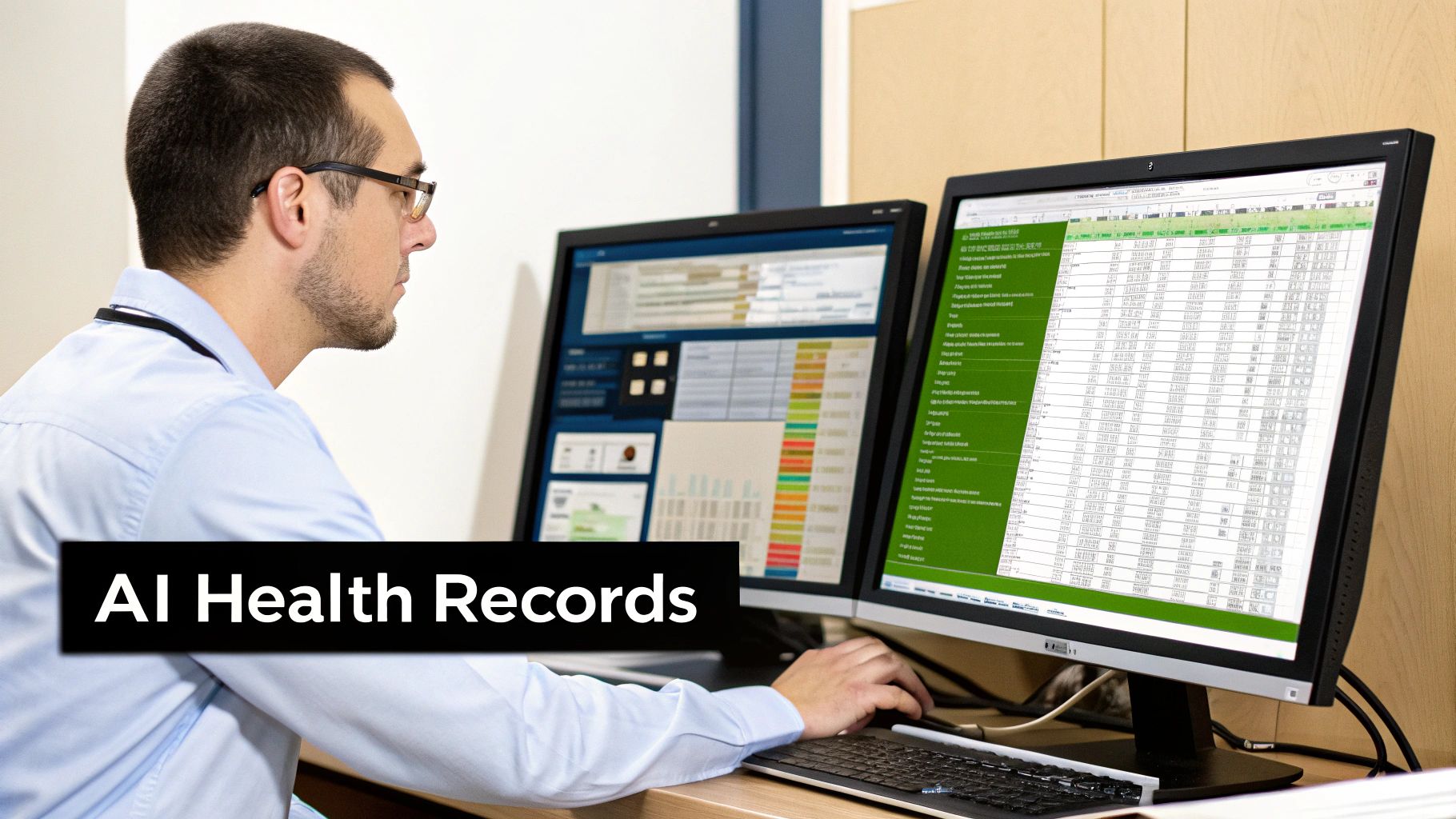
Bringing healthcare AI solutions into your organization can feel like a huge undertaking, but it doesn't have to be. With the right game plan, you can break it down into a clear, manageable process. The secret isn’t just about having the flashiest technology; real success comes from solid strategy, getting your people on board, and having a laser focus on solving the right problems from the get-go.
Your journey shouldn’t start with software, but with a simple question: What’s our biggest headache right now, clinically or operationally? Trying to roll out AI without a specific target is like prescribing a powerful medication without a diagnosis. You have to start by identifying a clear, high-impact problem where AI can make a real difference.
Step 1: Pinpoint the Right Problem
Before you even think about vendors or algorithms, you need to look inward. The most successful AI projects aren't driven by a desire to use cool tech; they’re born from the real-world challenges your teams face every day.
Get the conversation started by asking some tough questions to find the pain points:
- Where are our most frustrating operational bottlenecks? Is it patient scheduling, medical billing, or the back-and-forth of claims processing?
- Which clinical departments struggle with diagnostic delays or errors? Could we do better with our medical imaging analysis?
- What administrative drudgery is burning out our staff? Is it endless charting, managing inboxes, or wrestling with prior authorizations?
Zeroing in on a specific goal—like cutting down ER wait times or getting pathology reports turned around faster—gives you a clear target to aim for. This focus will guide every single decision you make from here on out, from collecting the right data to measuring what success actually looks like. A well-defined problem is your roadmap.
Step 2: Prepare Your Data Foundation
AI runs on data. Think of data as the fuel for your AI engine—without clean, high-quality fuel, the engine will just sputter and fail. Before you can even begin to train or use an AI model, you have to get your data house in order.
This stage involves a few critical actions:
- Data Auditing: First, take stock of what you have. What information are you already collecting in your Electronic Health Records (EHRs), Picture Archiving and Communication Systems (PACS), and other key platforms?
- Standardization: Next, make sure your data speaks the same language. If information from different systems is formatted inconsistently, it will only confuse the AI model and lead to garbage results.
- Anonymization and Security: Protecting patient privacy is absolutely non-negotiable. All data used to train or run AI must be completely and rigorously anonymized to comply with HIPAA and other privacy regulations.
Honestly, poor data quality is one of the most common reasons AI projects crash and burn. Taking the time to build a solid data foundation is the single most important investment you can make in the success of your project.
A successful AI implementation is built on a foundation of trust. This means ensuring patient data is secure, algorithms are fair and unbiased, and clinical staff are empowered, not replaced. Navigating regulatory frameworks like HIPAA is not just a legal requirement but a core part of building that trust.
Step 3: Choose the Right Technology and Partners
Once you have a clear problem and clean data, it’s time to start looking at technology. This doesn't automatically mean you have to build something from scratch. In fact, many organizations find it smarter to partner with specialized firms that live and breathe medical AI.
For teams wanting to move faster and avoid massive coding projects, looking into options like no-code AI app builders can be a fantastic strategic move. When you're vetting a potential partner, look closely at their track record in healthcare, how seriously they take data security, and whether their tools can integrate smoothly with your existing systems. A great partner will work with you to customize the solution to your unique workflow, making sure it feels like a natural extension of how your clinicians already work.
Step 4: Focus on People and Integration
This last step is arguably the most important one: the human element. You could have the most brilliant AI tool in the world, but if your staff won’t use it, it’s worthless. Getting buy-in from your clinical team is everything.
- Communicate the "Why": Be crystal clear about how the new AI tool is there to help them, not replace them. Frame it as a digital assistant that can take over the tedious, repetitive tasks, freeing them up to focus on what matters most—their patients.
- Provide Thorough Training: Make sure everyone who will touch the new system gets hands-on training that’s relevant to their specific role.
- Start Small and Iterate: Don't try to boil the ocean. Launch a pilot project in a single department first. Use the feedback from this initial rollout to iron out the kinks before you even think about expanding.
The industry's confidence in this area is growing rapidly. Healthcare executives around the world know that generative AI is set to make a massive impact. In a recent survey, more than 80% of health system leaders said they expect AI to have either a significant (26%) or moderate (55%) impact on their organizations this year alone. This growing momentum is why we're seeing new regulations designed to ensure these powerful tools are safe and effective for everyone involved.
Common Questions About AI in Medicine
As healthcare AI solutions weave their way into our clinics and hospitals, it’s completely natural for some tough but important questions to pop up. To move forward with confidence, we need to meet these concerns head-on, giving clinicians, administrators, and patients the clear answers they deserve.
Let’s dive into a few of the most common questions I hear.
The conversation almost always kicks off with the biggest fear: Will AI take my job? The short answer is a firm no.
The purpose of AI in medicine isn't to make doctors and nurses obsolete but to superpower them. Think of it less as an automated replacement and more like the most capable assistant a clinician has ever had. AI is perfect for tackling the repetitive, data-heavy work that grinds people down—like scouring thousands of medical images or transcribing visit notes. This frees up medical professionals to focus on what humans do best: critical thinking, patient connection, and delivering compassionate care.
How Can We Trust the AI to Be Fair?
This is a huge one. What about algorithmic bias? If an AI learns from data that mostly represents one type of person, it might stumble when it sees patients from other backgrounds. This is a serious risk that could actually make existing health disparities worse, which is the last thing anyone wants.
Tackling this requires a very intentional, ongoing effort.
- Diverse Training Data: Developers have a responsibility to build and train their models on datasets that truly reflect the entire patient population—across all ages, genders, and ethnicities.
- Continuous Auditing: Once an AI is in use, the work isn't done. These healthcare AI solutions need to be constantly monitored to see how they perform across different groups. If a bias starts to creep in, we have to catch it and fix it.
- Transparency in Performance: It's vital to be open about how an AI was trained and how well it actually works. This empowers healthcare organizations to make smart, informed choices about the tools they bring into their practice.
Safeguarding against bias isn't just a technical problem to solve; it's an ethical must-do. The goal is to build AI that fosters health equity, ensuring that technological progress benefits every single patient, no matter who they are.
What About Patient Privacy and Data Security?
Patient data is profoundly personal. The idea of feeding it into AI systems understandably sparks concerns about privacy and security. How can we be sure this information is kept confidential, especially with strict rules like HIPAA watching over everything?
Protecting patient data is the bedrock of any credible medical AI solution. It’s a process built with several layers of security.
The first and most important step is data anonymization. Before any data ever touches an AI model for training, every piece of personally identifiable information (PII)—names, addresses, you name it—is completely stripped away. The AI learns from de-identified data, recognizing medical patterns without ever knowing the person behind them.
On top of that, strong cybersecurity measures like encryption and secure access controls are non-negotiable. They protect the data at every single stage, whether it's stored away or actively being used. Complying with HIPAA isn't just about checking a legal box; it's a core principle of developing AI responsibly.
Is AI Only for Large, Wealthy Hospitals?
It's a common misconception that powerful AI tools are reserved for massive hospital systems with huge budgets. While it’s true that some large-scale systems are expensive, that's not the whole story anymore.
The growth of cloud computing and "AI-as-a-Service" (AIaaS) models is changing the game. Now, smaller clinics and private practices can tap into sophisticated AI without a massive upfront investment. Instead of buying and maintaining all the pricey hardware and software themselves, they can subscribe to AI services and just pay for what they use. This is leveling the playing field, making powerful healthcare AI solutions more accessible than ever.
For medical device companies looking to integrate cutting-edge AI without the massive overhead, PYCAD offers specialized services that bring world-class AI capabilities within reach. Explore how we can help you build the next generation of medical imaging tools.
